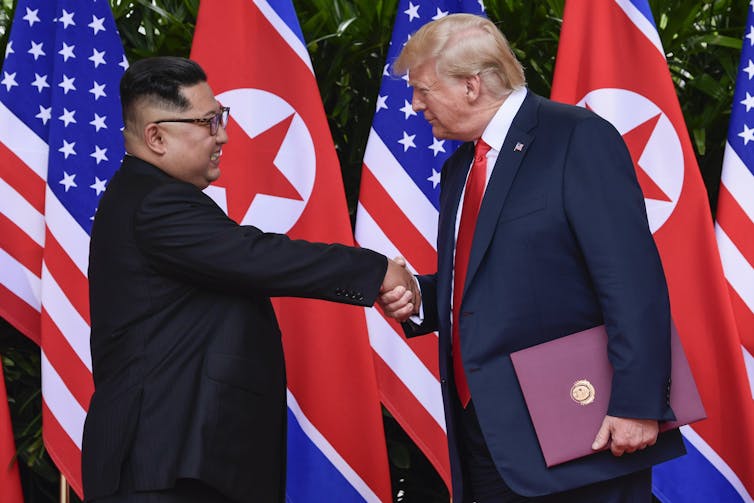
Stephen Benedict Dyson, University of Connecticut
Moments after President Donald Trump shook North Korean leader Kim Jong Un’s hand for the first time, Trump pronounced: “We will have a terrific relationship.”
Trump’s snap judgment fulfilled his prediction before the June 12 summit that he would be able to evaluate Kim’s intentions “within the first minute” of meeting him.
High-level politicians often think that they are experts at reading and influencing other leaders. They quickly come to believe that they are the world’s leading authority on any counterpart they meet in person. For example, President George W. Bush was so enamored with Iraqi Prime Minister Nouri al-Maliki that senior advisers launched a concerted campaign to curb his enthusiasm.
“You’re my man,” Bush would say to Maliki. When advisers told the president he was undercutting U.S. efforts to pressure Maliki, Bush responded with incredulity: “Are you saying I’m the problem?”
If Trump follows this pattern I’ve found when studying the personal side of foreign policy, he may believe that he now has special insight into Kim. And that means the dynamics of U.S. policymaking toward North Korea have changed. Having met Kim, the president will be even less likely to listen to experts in the intelligence and diplomatic communities.
From first impressions to agreement
Hours after Trump and Kim first met, the two leaders emerged from their talks to sign a joint document. The U.S. is prepared to guarantee the regime’s security, and North Korea is willing to “work towards complete denuclearization of the Korean peninsula,” according to the statement. Trump called it a “very comprehensive agreement.”
Critics are charging that the letter was closer to North Korea’s preferences than the “comprehensive, verifiable, irreversible de-nuclearization” sought by the United States.
Perhaps the document is underwhelming, repeating North Korean promises of the past without any clear road map to making them reality. But something significant changed in Singapore: President Trump has met Kim face to face.
Intelligence
On the eve of the summit, details emerged of a profile of Kim’s personality, provided to the president by allied intelligence agencies.
This is standard practice prior to meetings with foreign leaders. But once the leaders have met in person, intelligence analysis takes second place to first-hand impressions.
In the future, expert counsel on Kim’s intentions may clash with Trump’s positive perception of the North Korean leader. In the post-summit press conference Trump called Kim “very talented.” He told journalist Greta van Susteren that Kim has “a great personality, he’s a funny guy, he’s very smart. He loves his people.”
From now on, analyses from the diplomatic and intelligence communities that fit Trump’s view of Kim will be favored, those at odds with his view may be dismissed.
This dynamic is common in policymaking, and there are reasons to think it could be extremely consequential in this case.
Relying on ‘touch, feel’
First, Trump’s tendency to trust his instincts is already pronounced. Asked by a reporter before the summit how he would know if Kim was serious about de-nuclearization, Trump said he would rely upon “my touch, my feel. It’s what I do.”
Second, the intricate series of steps toward disarmament of a nuclear arsenal require expert verification. Ostensibly cooperative actions – like destroying nuclear test tunnels – might turn out to be empty gestures once analysts have pored over the surveillance footage. The North Korean regime has a history of making public agreements, then advancing their nuclear arsenal in secret.
![]() This summit process began with a snap decision by Trump to accept an offer to meet with Kim. The most significant result may be Trump’s new confidence that he uniquely understands the North Korean leader. This will further reinforce the defining dynamic of Trump’s presidency so far: Ignore the experts, trust your gut.
This summit process began with a snap decision by Trump to accept an offer to meet with Kim. The most significant result may be Trump’s new confidence that he uniquely understands the North Korean leader. This will further reinforce the defining dynamic of Trump’s presidency so far: Ignore the experts, trust your gut.
Stephen Benedict Dyson, Associate Professor of Political Science, University of Connecticut
This article was originally published on The Conversation. Read the original article.

















